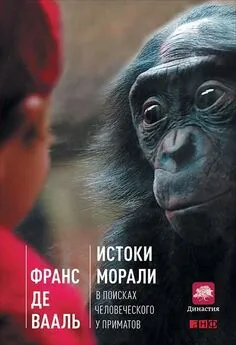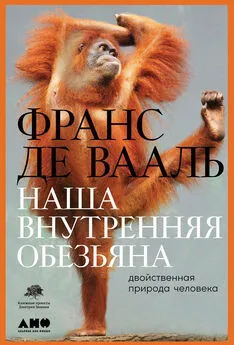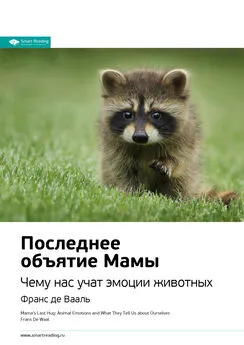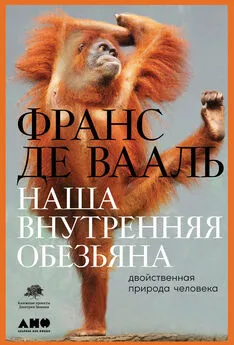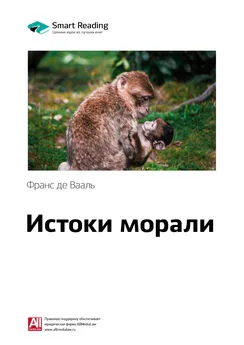Франс де Вааль - Достаточно ли мы умны, чтобы судить об уме животных?
- Название:Достаточно ли мы умны, чтобы судить об уме животных?
- Автор:
- Жанр:
- Издательство:ЛитагентАльпина6bdeff1e-120c-11e2-86b3-b737ee03444a
- Год:2017
- Город:Москва
- ISBN:978-5-9614-4452-0
- Рейтинг:
- Избранное:Добавить в избранное
-
Отзывы:
-
Ваша оценка:
Франс де Вааль - Достаточно ли мы умны, чтобы судить об уме животных? краткое содержание
В течение большей части прошедшего столетия наука была чрезмерно осторожна и скептична в отношении интеллекта животных. Исследователи поведения животных либо не задумывались об их интеллекте, либо отвергали само это понятие. Большинство обходило эту тему стороной. Но времена меняются. Не проходит и недели, как появляются новые сообщения о сложности познавательных процессов у животных, часто сопровождающиеся видеоматериалами в Интернете в качестве подтверждения.
Какие способы коммуникации практикуют животные и есть ли у них подобие речи? Могут ли животные узнавать себя в зеркале? Свойственны ли животным дружба и душевная привязанность? Ведут ли они войны и мирные переговоры? В книге читатели узнают ответы на эти вопросы, а также, например, что крысы могут сожалеть о принятых ими решениях, воро́ны изготавливают инструменты, осьминоги узнают человеческие лица, а специальные нейроны позволяют обезьянам учиться на ошибках друг друга. Ученые открыто говорят о культуре животных, их способности к сопереживанию и дружбе. Запретных тем больше не существует, в том числе и в области разума, который раньше считался исключительной принадлежностью человека.
Автор рассказывает об истории этологии, о жестоких спорах с бихевиористами, а главное – об огромной экспериментальной работе и наблюдениях за естественным поведением животных. Анализируя пути становления мыслительных процессов в ходе эволюционной истории различных видов, Франс де Вааль убедительно показывает, что человек в этом ряду – лишь одно из многих мыслящих существ.
Достаточно ли мы умны, чтобы судить об уме животных? - читать онлайн бесплатно ознакомительный отрывок
Интервал:
Закладка:
Dunbar, R. 1998a. Grooming, Gossip, and the Evolution of Language. Cambridge, MA: Harvard University Press.
–. 1998b. The social brain hypothesis. Evolutionary Anthropology 6:178–90. Emery, N. J., and N. S. Clayton. 2001. Effects of experience and social context on prospective caching strategies by scrub jays. Nature 414:443–46.
–. 2004. The mentality of crows: Convergent evolution of intelligence in corvids and apes. Science 306:1903–7.
Epstein, R. 1987. The spontaneous interconnection of four repertoires of behavior in a pigeon. Journal of Comparative Psychology 101:197–201.
Epstein, R., R. P. Lanza, and B. F. Skinner. 1981. "Self-awareness" in the pigeon. Science 212:695–96.
Evans, T. A., and M. J. Beran. 2007. Chimpanzees use self-distraction to cope with impulsivity. Biology Letters 3:599–602.
Falk, J. L. 1958. The grooming behavior of the chimpanzee as a reinforcer. Journal of the Experimental Analysis of Behavior 1:83–85.
Fehr, E., and U. Fischbacher. 2003. The nature of human altruism. Nature 425:785–91.
Ferris, C. F., et al. 2001. Functional imaging of brain activity in conscious monkeys responding to sexually arousing cues. Neuroreport 12:2231–36.
Finn, J. K., T. Tregenza, and M. D. Norman. 2009. Defensive tool use in a coconut-carrying octopus. Current Biology 19: R1069–70.
Fodor, J. 1975. The Language of Thought. New York: Crowell.
Foerder, P., et al. 2011. Insightful problem solving in an Asian elephant. Plos ONE 6 (8):e23251.
Foote, A. L., and J. D. Crystal. 2007. Metacognition in the rat. Current Biology 17:551–55.
Foster, M. W., et al. 2009. Alpha male chimpanzee grooming patterns: Implications for dominance "style." American Journal of Primatology 71:136–44.
Fragaszy, D. M., E. Visalberghi, and L. M. Fedigan. 2004. The Complete Capuchin: The Biology of the Genus Cebus. Cambridge: Cambridge University Press.
Frankfurt, H. G. 1971. Freedom of the will and the concept of a person. Journal of Philosophy 68:5–20.
Fuhrmann, D., A. Ravignani, S. Marshall-Pescini, and A. Whiten. 2014. Synchrony and motor mimicking in chimpanzee observational learning. Scientific Reports 4:5283.
Gácsi, M., et al. 2009. Explaining dog wolf differences in utilizing human pointing gestures: Selection for synergistic shifts in the development of some social skills. Plos ONE 4: e6584.
Galef, B. G. 1990. The question of animal culture. Human Nature 3:157–78. Gallup, G. G. 1970. Chimpanzees: Self-recognition. Science 167:86–87.
Garcia, J., D. J. Kimeldorf, and R. A. Koelling. 1955. Conditioned aversion to saccharin resulting from exposure to gamma radiation. Science 122:157–58. Gardner, R. A., M. H. Scheel, and H. L. Shaw. 2011. Pygmalion in the laboratory. American Journal of Psychology 124:455–61.
Garstang, M., et al. 2014. Response of African elephants ( Loxodonta africana ) to seasonal changes in rainfall. Plos ONE 9: e108736.
Gaulin, S. J. C., and R. W. Fitzgerald. 1989. Sexual selection for spatial-learning ability. Animal Behaviour 37:322–31.
Geissmann, T., and M. Orgeldinger. 2000. The relationship between duet songs and pair bonds in siamangs, Hylobates syndactylus. Animal Behaviour 60: 805–9. Goodall, J. 1967. My Friends the Wild Chimpanzees. Washington, DC: National
Geographic Society.
–. 1971. In the Shadow of Man. Boston: Houghton Miff lin.
–. 1986. The Chimpanzees of Gombe: Patterns of Behavior. Cambridge, MA: Belknap.
Gould, J. L., and C. G. Gould. 1999. The Animal Mind . New York: W. H. Freeman. Gouzoules, S., H. Gouzoules, and P. Marler. 1984. Rhesus monkey ( Macaca mulatta ) screams: Representational signaling in the recruitment of agonistic aid. Animal Behaviour 32:182–93.
Griffin, D. R. 1976. The Question of Animal Awareness: Evolutionary Continuity of Mental Experience . New York: Rockefeller University Press.
–. 2001. Return to the magic well: Echolocation behavior of bats and responses of insect prey. Bioscience 51:555–56.
Gruber, T., Z. Clay, and K. Zuberbühler. 2010. A comparison of bonobo and chimpanzee tool use: Evidence for a female bias in the Pan lineage. Animal Behaviour 80:1023–33.
Guldberg, H. 2010. Just Another Ape? Exeter, UK: Imprint Academic.
Gumert, M. D., M. Kluck, and S. Malaivijitnond. 2009. The physical characteristics and usage patterns of stone axe and pounding hammers used by long-tailed macaques in the Andaman Sea region of Thailand. American Journal of Primatology 71:594–608.
Günther, M. M., and C. Boesch. 1993. Energetic costs of nut-cracking behaviour in wild chimpanzees. In Hands of Primates, ed. H. Preuschoft and D. J. Chivers, 109–29. Vienna: Springer.
Gupta, A. S., M. A. A. van der Meer, D. S. Touretzky, and A. D. Redish.
2010. Hippocampal replay is not a simple function of experience. Neuron 65:695–705.
Guthrie, E. R., and G. P. Horton. 1946. Cats in a Puzzle Box. New York: Rinehart.
Hall, K., et al. 2014. Using cross correlations to investigate how chimpanzees use conspecific gaze cues to extract and exploit information in a foraging competition. American Journal of Primatology 76:932–41.
Hamilton, G. 2012. Crows can distinguish faces in a crowd. National Wildlife Federation, Nov. 7, http://bit.ly / 1IqkWaN.
Hampton, R. R. 2001. Rhesus monkeys know when they remember. Proceedings of the National Academy of Sciences USA 98:5359–62.
Hampton, R. R., A. Zivin, and E. A. Murray. 2004. Rhesus monkeys ( Macaca mulatta ) discriminate between knowing and not knowing and collect information as needed before acting. Animal Cognition 7:239–54.
Hanlon, R. T. 2007. Cephalopod dynamic camouf lage. Current Biology 17: R400–4.
–. 2013. Camouf laged octopus makes marine biologist scream bloody murder (video). Discover , Sept. 13, http://bit.ly / 1RScdid.
Hanlon, R. T., and J. B. Messenger. 1996. Cephalopod Behaviour . Cambridge: Cambridge University Press.
Hanlon, R. T., J. W. Forsythe, and D. E. Joneschild. 1999. Crypsis, conspicuousness, mimicry and polyphenism as antipredator defences of foraging octopuses on indo-pacific coral reefs, with a method of quantifying crypsis from video tapes. Biological Journal of the Linnean Society 66:1–22.
Hanus, D., N. Mendes, C. Tennie, and J. Call. 2011. Comparing the performances of apes ( Gorilla gorilla, Pan troglodytes, Pongo pygmaeus ) and human children ( Homo sapiens ) in the f loating peanut task. PLoS ONE 6: e19555.
Hare, B., M. Brown, C. Williamson, and M. Tomasello. 2002. The domestication of social cognition in dogs. Science 298:1634–36.
Hare, B., J. Call, and M. Tomasello 2001. Do chimpanzees know what conspecifics know? Animal Behaviour 61:139–51.
Hare, B., and M. Tomasello. 2005. Human-like social skills in dogs? Trends in Cognitive Sciences 9:440–45.
Hare, B., and V. Woods. 2013. The Genius of Dogs: How Dogs Are Smarter Than You Think. New York: Dutton.
Harlow, H. F. 1953. Mice, monkeys, men, and motives. Psychological Review 60: 23–32.
Hattori, Y., F. Kano, and M. Tomonaga. 2010. Differential sensitivity to conspecific and allospecific cues in chimpanzees and humans: A comparative eye-tracking study. Biology Letters 6:610–13.
Hattori, Y., K. Leimgruber, K. Fujita, and F. B. M. de Waal. 2012. Food-related tolerance in capuchin monkeys ( Cebus apella ) varies with knowledge of the partner's previous food-consumption. Behaviour 149:171–85.
Heisenberg, W. 1958. Physics and Philosophy: The Revolution in Modern Science. London: Allen and Unwin.
Herculano-Houzel, S. 2009. The human brain in numbers: A linearly scaled-up primate brain. Frontiers in Human Neuroscience 3 (2009): 1–11.
–. 2011. Brains matter, bodies maybe not: The case for examining neuron numbers irrespective of body size. Annals of the New York Academy of Sciences 1225:191–99.
Herculano-Houzel, S., et al. 2014. The elephant brain in numbers. Neuroanatomy 8:10.3389 / fnana.2014.00046.
Herrmann, E., et al. 2007. Humans have evolved specialized skills of social cognition: The cultural intelligence hypothesis. Science 317:1360–66.
Herrmann, E., V. Wobber, and J. Call. 2008. Great apes' ( Pan troglodytes, P. paniscus, Gorilla gorilla, Pongo pygmaeus ) understanding of tool functional properties after limited experience. Journal of Comparative Psychology 122:220–30.
Heyes, C. 1995. Self-recognition in mirrors: Further ref lections create a hall of mirrors. Animal Behaviour 50: 1533–42.
Hillemann, F., T. Bugnyar, K. Kotrschal, and C. A. F. Wascher. 2014. Waiting for better, not for more: Corvids respond to quality in two delay maintenance tasks. Animal Behaviour 90: 1–10.
Hirata, S., K. Watanabe, and M. Kawai. 2001. "Sweet-potato washing" revisited. In Primate Origins of Human Cognition and Behavior , ed. T. Matsuzawa, 487–508. Tokyo: Springer.
Hobaiter, C., and R. Byrne. 2014. The meanings of chimpanzee gestures. Current Biology 24:1596–600.
Hodos, W., and C. B. G. Campbell. 1969. Scala naturae: Why there is no theory in comparative psychology. Psychological Review 76:337–50.
Hopper, L. M., S. P. Lambeth, S. J. Schapiro, and A. Whiten. 2008. Observational learning in chimpanzees and children studied through "ghost" conditions. Proceedings of the Royal Society of London B 275:835–40.
Horner, V., et al. 2010. Prestige affects cultural learning in chimpanzees. Plos ONE 5: e10625.
Horner, V., D. J. Carter, M. Suchak, and F. B. M. de Waal. 2011. Spontaneous prosocial choice by chimpanzees. Proceedings of the Academy of Sciences, USA 108:13847–51.
Horner, V., and F. B. M. de Waal. 2009. Controlled studies of chimpanzee cultural transmission. Progress in Brain Research 178:3–15.
Horner, V., A. Whiten, E. Flynn, and F. B. M. de Waal. 2006. Faithful replication of foraging techniques along cultural transmission chains by chimpanzees and children. Proceedings of the National Academy of Sciences USA 103:13878–83.
Horowitz, A. 2010. Inside of a Dog: What Dogs See, Smell, and Know. New York: Scribner.
Hostetter, A. B., M. Cantero, and W. D. Hopkins. 2001. Differential use of vocal and gestural communication by chimpanzees ( Pan troglodytes ) in response to the attentional status of a human ( Homo sapiens ). Journal of Comparative Psychology 115:337–43.
Howell, T. J., S. Toukhsati, R. Conduit, and P. Bennett. 2013. The perceptions of dog intelligence and cognitive skills (PoDIaCS) survey. Journal of Veterinary Behavior: Clinical Applications and Research 8:418–24.
Huffman, M. A. 1996. Acquisition of innovative cultural behaviors in nonhuman primates: A case study of stone handling, a socially transmitted behavior in Japanese macaques. In Social Learning in Animals: The Roots of Culture, ed. C. M. Heyes and B. Galef, 267–89. San Diego: Academic Press.
Hume, D. 1985 [orig. 1739]. A Treatise of Human Nature. Harmondsworth, UK: Penguin.
Hunt, G. R. 1996. The manufacture and use of hook tools by New Caledonian crows. Nature 379:249–51.
Читать дальшеИнтервал:
Закладка:
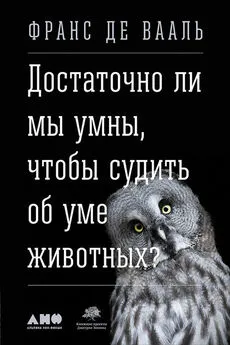

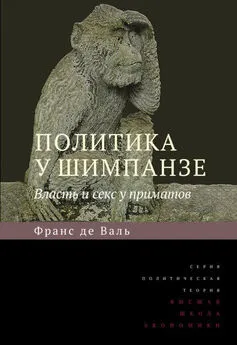
![Франс Вааль - Последнее объятие Мамы [litres]](/books/1075030/frans-vaal-poslednee-obyatie-mamy-litres.webp)
